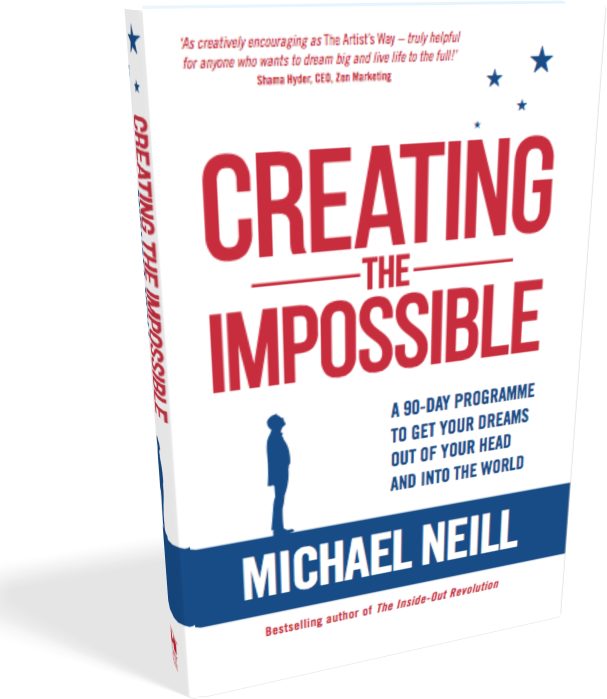The first book I wrote after stumbling across the inside-out understanding was called Supercoach: 10 Secrets to Transform Anyone’s Life. At the time, I thought I was definitively laying out a new paradigm in understanding human behavior and at the same time, introducing the work of Syd Banks and the Three Principles (3P) to a wider audience.
While the book was well received publicly, it was not a hit in the 3P world. One notable member of the community, on being handed a brand new hot off the press copy of the book, scanned it briefly, tossed it aside, and said “This is the kind of book Syd hates.” This puzzled me, but I chalked it up to either field-specific insularity or professional jealousy (you might chalk it up to my enormously “healthy” ego) and carried on promoting the book.
Over the next few years, I continued to go deeper into my study of the principles and eventually saw what it was that my teachers and mentors were pointing to. I had inadvertently written a book based on a mixed paradigm – a worldview where sometimes things work according to one set of principles and at other times work according to a different set. More specifically, some elements of our experience seemed to come directly into consciousness via thought, while other elements seemed to come indirectly by way of specific life circumstances. Consequently, in order to have a better life, some things required intervention in the world of form and others changed in the formless world of the deeper mind.
While my ‘thought/circumstance’ percentages gradually shifted over the years, eventually, I started to see that lasting transformation – seeing a deeper truth that allows us to live in a different world – required a 100% solution. Either our experience comes to us via thought, or it comes at us and is occasionally mitigated by thought. It’s as black and white as gravity, and our beliefs about it don’t make a bit of difference to its effects.
So this year I’ve set out to produce a 10th anniversary revised and updated edition of Supercoach, staying as true as I can to the original structure while clarifying the understanding as things look to me now.
Here’s an excerpt from the first part of the book….
“All miracles involve a shift in perception.”
— A Course in Miracles
Traditional coaching takes place primarily on a horizontal dimension—coaches assist their clients in getting from point A to point B. Yet lasting, sustainable change nearly always happens in the vertical dimension – a deepening of the ground of being of the client and greater access to inspiration and spiritual wisdom. While this has generally led to an either-or approach to success and personal growth and a sharp division between therapy and coaching, transformative coaching (or, as I like to call it, “supercoaching”) uses the vertical dimensions to create change on the inside while you continue to move forward toward your goals on the outside.
The kinds of “vertical” changes that transformative coaching leads to can be usefully viewed on three levels…
Level I: Change in a Specific Situation
Often people will hire a coach (or go to a counselor, therapist, or friend) to get help with a specific situation they’re struggling with. They may want to deal with a difficult person at work, succeed at an important negotiation or job interview, or stay motivated as they train to beat their personal best at a sporting event.
This kind of “performance coaching” has long been a staple of the industry, and long before “life coaching” and “executive coaching” became common terms, people were using coaches in this capacity to help change their points of view, states of mind, or actions. At this level, people go from fear to confidence, from unease to comfort, or from inaction to action.
The impact of this kind of coaching is generally project specific. Once the difficult person has been handled, the interview completed, or the race run, people get on with the rest of their lives in much the same way they did before.
Level II: Change in a Specific Life Area
Sometimes we’re less concerned with a specific event than we are with a whole category of events. This is why we find coaches specializing in any number of life areas: relationships, sales, parenting, confidence, presentations. . . the list goes on and on. People hire these experts to help them develop their confidence and increase their skills in whatever area they may be having difficulty. Like performance coaches, these coaches will help with specific situations, but they tend to measure their impact not just by how one situation changes, but by how their whole category of situations changes.
Level III: Transformation
The ultimate level of change is transformation, or what I sometimes call “global change”—a pervasive shift in our way of understanding and being in the world. At this level, it’s not enough for us to develop a skill or change a feeling. We want to wake up to our higher potential and wake up from the dream of thought, because in so doing our experience of everything changes and we begin to walk in a different world.
Each of the three levels maps across to a certain kind of intervention. When we want to make a change in the moment or in a specific situation, we apply a technique. When we want to make a change in a broader context, we install new strategies. But when we want to actually transform lives, we need more than just strategies or techniques. We need to see what’s actually generically true about life and the mind so that we can live more in harmony with how things actually work.
How else do the three levels of change differ?
Well, levels I and II are primarily intervention based, where level I interventions take care of the presenting problem while level II interventions aim to take care of whatever is seen as the underlying cause. This can be helpful, but it can also lead people deeper into the morass of their own psychology. For example people heavily into personal development sometimes get fixated on finding Level II solutions for Level I problems—they’ve got a headache, but instead of taking an aspirin, they want to analyze the lifestyle changes they need to make to become the kind of person who doesn’t get headaches. It’s an interesting idea, but it’s a lot easier to do when your head isn’t hurting.
At level III, we’re simply looking for what’s true about human beings regardless of individual differences. Either our experience is made 100% of thought or it’s made of thought plus circumstance. And if you really see that your headache is a 100% thought-created phenomenon, you may still take the aspirin, but knowing that the headache will pass as thought changes takes the pressure off you to change it.
The Three Levels in Action
Let’s take a couple of more in depth examples. Bob is a customer service rep for a medium-sized manufacturing firm, and he’s having a really bad day. When I ask him what his biggest sticking point is, he tells me it’s a phone call he needs to make to a supplier in Detroit he’s been having difficulties with.
If I were to approach this on Level I, I might work with his frame of mind by helping him get into a more confident state. We might role-play a phone call with his supplier, and I would offer him tips and techniques to better handle the call and get the outcome he most wants. We might even choose to script the call, or at least the beginning of it, to help boost his confidence and resolve the situation.
But let’s say I want more for Bob—I don’t just want to assist him in getting through this one situation; I want to help turn him into a more effective employee, one who can handle a wider variety of customer service situations. At that point, I could give him books like How to Talk So People Listen. I could teach him rapport skills like “matching and mirroring” so he could use body language to effectively allow others to feel more comfortable around him.
In time and with practice, Bob might well be able to turn things around and maybe even become the best customer service guy in the whole company. But in another way, nothing will have really changed. Because in order for something to change at a fundamental level, that change has to happen via insight – a sight from within.
So at the level of transformation, our conversation will no longer be about the supplier from Detroit or even about customer service. Our level III conversation will be about the nature of service and satisfaction – what they are and where they come from. In exploring these universal truths, Bob will get insight and fresh thinking that changes the way he sees himself, the way he sees his job, and the way he sees other people. And through those insights, Bob will not only become more effective in his job, he’ll also become more effective in his life.
Here’s another example, one that might hit closer to home: Imagine you’re having difficulties with your resident teenager. You want them to help out around the house and be more respectful toward you and your partner, but they seem determined to set a new world record for “most dirty clothes piled up in one corner of a bedroom.”
At Level I, you could go in guns a-blazing and order them to pick up their dirty clothes “or else.” You might even try a subtler approach—the dangling carrot of concert tickets or a shopping trip to the nearest mall in exchange for a cleaner room.
At Level II, you might read parenting books that would tell you how to handle discipline problems with teens, or even one on how to handle difficult people at work in the hopes that you could map it across to your own child at home. (Of course, if you come across a copy of What to Do When You Work for an Idiot in their bedroom, chances are they’re planning a little Level II intervention with you!)
But at Level III, you would know that the difference that will really make a difference is insight—a shift in consciousness that comes about through seeing a deeper truth about how life works.
For example, when my daughter Clara was six, she went through a period of violent temper tantrums that frightened her teachers to the point where they were considering either putting her on medication or kicking her out of school. My wife and I had no clue what to do about it, so we turned to one of my mentors, Bill Cumming.
His “coaching” addressed all three levels simultaneously. At Level I, he would continually check in with us to ensure that we were doing okay within ourselves—that is, we were getting adequate sleep, food, and exercise and doing whatever else we needed for what he called our “spiritual self-care”.
At Level II, he shared some wonderful strategies for dealing with difficult children. The one that sticks in my mind is the two C’s: clarity and consistency. We got clear about what was and wasn’t okay, and got more consistent in our enforcement of those rules.
But in all honesty, other than taking our mind off the problem and focusing us on what we could actually do instead of obsessing about everything that might go wrong, I’m not sure that those things made much of a difference.
What has stayed with us to this day, however, was insight from our conversations into where Clara’s experience was coming from and the nature of unconditional love. It became obvious to us that the only reason someone would behave in the way Clara was behaving was if the person felt unwell within themselves. Her behavior was actually an attempt to make herself feel better.
As we began to see the discomfort in Clara that was leading to her acting out, it became much easier not to take her behavior personally, as if it was her way of punishing us for our parenting failures. More important, any catastrophizing we’d been doing in our heads about how this would be a problem for the rest of her life, and if it was this bad now, “imagine how bad it will be when she’s a teenager,” fell away.
We began to see her as a little girl doing the best she could to manage her feelings, in this instance by controlling her environment through a reign of six-year-old terror. We knew that when she had a better understanding of what feelings are and where they come from, her innate wisdom and common sense would guide her forward. That made it easy and natural to feel the full force of our love for her, even when she was behaving in ways that were shocking and at times a little bit frightening for us.
It no longer made sense to me to send her to her room when she had a tantrum in a behaviorist effort to “extinguish” the unwanted behavior. What occurred to me to do was to go into her room with her and just quietly be with her as she worked through whatever it was she was working through.
At first, she didn’t seem to like this new approach. Instead of simply putting holes in the walls of her bedroom, she seemed hell-bent on putting a few in my head. But after a few tantrums, she somehow recognized that she was safe and all was well, even when she was suffering from the mental clutter and discomfort that affects all of us from time to time. That feeling of safety allowed her natural wisdom, clarity, and well being came back to the fore.
Now, as a young adult, Clara is more secure in herself and her thinking than most people I know. And while we certainly had our share of issues during her teenage years, the closeness and insight we gleaned when she was six went a long way to seeing us through them.
I’ll be sharing more excerpts and updates in the coming weeks!
With all my love,
![]()


 Now available worldwide from these retailers and all bookstores
Now available worldwide from these retailers and all bookstores







